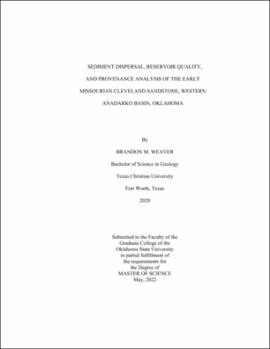| dc.contributor.advisor | Puckette, James | |
| dc.contributor.author | Weaver, Brandon M. | |
| dc.date.accessioned | 2023-04-03T20:51:42Z | |
| dc.date.available | 2023-04-03T20:51:42Z | |
| dc.date.issued | 2022-05 | |
| dc.identifier.uri | https://hdl.handle.net/11244/337241 | |
| dc.description.abstract | Distribution of Late Paleozoic strata in the Anadarko basin was driven by a complex interplay between the tectonic activity of several potential source areas, cyclic flooding of the North American Craton due to Gondwanan glaciation driven by Milankovitch cycles, and basin physiography. During the early Missourian, the Cleveland Sandstone was being deposited in the western Anadarko basin as well as on the Cherokee platform in central and eastern Oklahoma via fluvial systems; petrographic work performed in this study reveals key differences in the formation between the two areas which may indicate a change in provenance. The Cleveland Sandstone as it occurs in the study area contains abundant low-grade metamorphic rock fragments, where dissolution of these grains creates the majority of porosity in this important hydrocarbon reservoir. This study reports 270 concordant detrital zircon U-Pb ages and 27 new εHf(t) values for the one Cleveland sample analyzed; this is the first reported geochronologic data for the formation. Incorporation of petrographic work with detrital zircon geochronology allows for a greater understanding of sediment dispersal and provenance of this tight sandstone reservoir, which remains poorly understood. Zircons in the sample analyzed are characterized by an abundance of ages corresponding to the Grenville province (1300-950 Ma), with significant amounts of grains also corresponding to Middle Paleozoic sources (490-270 Ma), Neoproterozoic sources (790-530 Ma), and the Granite-Rhyolite province (1600-1300 Ma). Comparative analysis of published detrital zircon ages and εHf(t) values from Late Paleozoic strata in several different basins, as well as from basement rocks across the North American Craton, reveal that the Cleveland Sandstone was likely sourced primarily from distal extrabasinal systems rather than local source areas; these are likely Gondwanan terranes accreted along the Ouachita-Marathon thrust belt to the south, namely the Yucatan, Maya, and Coahuila blocks. Petrographic work supports previous interpretations of a west-east trending incised fluvial valley that deposited the Cleveland Sandstone as it occurs in the study area. These findings have broader implications on Late Pennsylvanian sediment dispersal in the Anadarko basin, as the presence of these southerly-derived grains have only recently been documented in published literature. | |
| dc.format | application/pdf | |
| dc.language | en_US | |
| dc.rights | Copyright is held by the author who has granted the Oklahoma State University Library the non-exclusive right to share this material in its institutional repository. Contact Digital Library Services at lib-dls@okstate.edu or 405-744-9161 for the permission policy on the use, reproduction or distribution of this material. | |
| dc.title | Sediment dispersal, reservoir quality, and provenance analysis of the early Missourian Cleveland Sandstone, western Anadarko Basin, Oklahoma | |
| dc.contributor.committeeMember | Hileman, Mary | |
| dc.contributor.committeeMember | Pashin, Jack | |
| dc.contributor.committeeMember | Knapp, James | |
| osu.filename | Weaver_okstate_0664M_17620.pdf | |
| osu.accesstype | Open Access | |
| dc.type.genre | Thesis | |
| dc.type.material | Text | |
| dc.subject.keywords | Anadarko | |
| dc.subject.keywords | Cleveland | |
| dc.subject.keywords | detrital zircon | |
| dc.subject.keywords | Pennsylvanian | |
| dc.subject.keywords | provenance | |
| thesis.degree.discipline | Geology | |
| thesis.degree.grantor | Oklahoma State University | |
